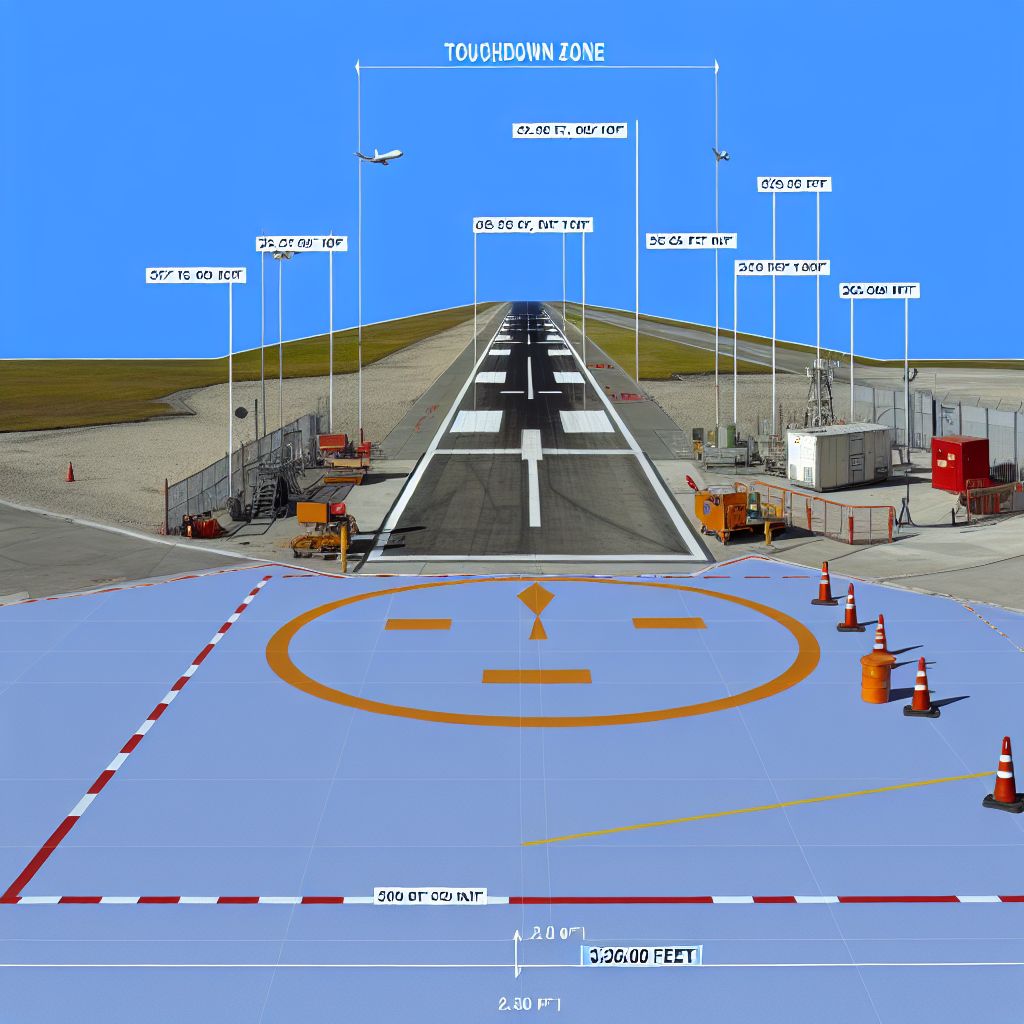Deutsch: Landezone / Español: Zona de aterrizaje / Português: Zona de pouso / Français: Zone d'atterrissage / Italiano: Zona di atterraggio /
The touchdown zone (TDZ) is the first 3000 feet (roughly 1000 m) of the Runway or the first third of the runway, whichever is less, measured from the threshold.
Description

The 'Touchdown zone' in the Space industry refers to a designated area on a planetary surface or Spacecraft landing platform where a spacecraft or rover is intended to make contact during landing maneuvers. It is a Critical phase of a mission, where precise alignment and control are required to ensure a safe and successful touchdown. The touchdown zone is typically selected based on factors such as surface Composition, terrain topology, and mission objectives. Engineers and mission planners carefully analyze and designate touchdown zones to minimize landing risks and maximize mission success. During landing, spacecraft or rovers deploy landing gear or landing systems to absorb impact forces and maintain stability upon touchdown.
Application Areas
- Planetary Exploration: Touchdown zones are designated on planetary surfaces for spacecraft and rovers conducting scientific exploration missions, such as Mars rovers or lunar landers.
- Crewed Missions: Touchdown zones are established for crewed spacecraft returning from Space missions, ensuring safe landings for astronauts returning to Earth.
- Cargo Delivery: Touchdown zones are identified for cargo delivery spacecraft, such as resupply missions to space stations, to safely deliver payloads to designated locations.
- Sample Return Missions: Touchdown zones are selected for sample return missions, allowing spacecraft to retrieve scientific samples from planetary surfaces for analysis on Earth.
Treatment and Risks
- Treatment:
- Precise Navigation: Advanced navigation systems and sensors are used to accurately guide spacecraft to designated touchdown zones during landing maneuvers.
- Landing Gear Design: Robust landing gear systems are designed to withstand impact forces and maintain stability upon touchdown, ensuring safe landings.
- Risks:
- Terrain Hazards: Touchdown zones may contain hazards such as rocks, craters, or steep slopes, posing risks to spacecraft during landing operations.
- Environmental Factors: Atmospheric conditions, surface composition, and gravitational forces can affect spacecraft behavior during landing, increasing the Complexity and risks of touchdown operations.
Examples
- Designating a specific area on a planetary surface for the landing of spacecraft, such as a designated landing site on Mars or the Moon.
- Identifying a precise location for the touchdown of lunar or planetary exploration rovers to ensure safe and controlled landings.
- Defining the touchdown zone for reusable Launch Vehicles (RLVs) during descent and landing phases to minimize landing hazards and ensure vehicle recovery.
- Establishing touchdown zones for crewed spacecraft returning from space missions, such as designated landing sites for space capsules in remote areas or on Ocean surfaces.
- Planning touchdown zones for spacecraft conducting sample return missions, ensuring the safe retrieval of scientific samples from Celestial bodies.
These examples illustrate various scenarios where the concept of 'Touchdown zone' is applied in the space industry, emphasizing its importance for safe and precise landings of spacecraft.
Of course! Here are some synonyms or similar terms for 'Touchdown zone' in the space industry context:
Similar Concepts and Synonyms
- Landing area
- Landing zone
- Landing site
- Touchdown point
- Landing region
These terms describe similar concepts to 'Touchdown zone' in the context of spacecraft landings and landing sites in space exploration.
Summary
Summary
the 'Touchdown zone' in the space industry is a designated area on a planetary surface or spacecraft landing platform where a spacecraft or rover is intended to make contact during landing maneuvers. Touchdown zones are critical for ensuring safe and successful landings of spacecraft, rovers, and cargo delivery vehicles in various space exploration missions. Despite the challenges and risks associated with touchdown operations, precise navigation, robust landing gear design, and careful mission planning are essential for mitigating risks and achieving successful landings in space exploration endeavors.
--
Related Articles to the term 'Touchdown zone' | |
| 'Reentry' | ■■■■■■ |
| Reentry is a critical phase of a spacecraft or a missile\'s mission, where it enters the Earth\'s atmosphere . . . Read More | |
| 'Mars' | ■■■■■ |
| In the aerospace context, Mars refers to the fourth planet from the Sun in the solar system. Mars is . . . Read More | |
| 'Perseverance' | ■■■■■ |
| Perseverance is the name of a NASA\'s Mars rover mission that was launched in July 2020 and landed on . . . Read More | |
| 'Spirit' | ■■■■■ |
| Spirit in the space industry context refers to the Mars Exploration Rover named \'Spirit.\' Spirit was . . . Read More | |
| 'Sojourner' | ■■■■■ |
| Sojourner in the Space industry context refers to the first Mars rover deployed by NASA as part of the . . . Read More | |
| 'Mastcam' | ■■■■■ |
| Mastcam is a sophisticated imaging system used in the Space industry, primarily deployed on Mars rovers . . . Read More | |
| 'Mobility' | ■■■■■ |
| Deutsch: Mobilität / Español: Movilidad / Português: Mobilidade / Français: Mobilité / Italiano: . . . Read More | |
| 'Arrival' | ■■■■■ |
| Arrival in the Space industry context refers to the successful completion of a spacecraft\'s journey . . . Read More | |
| 'Stratosphere' | ■■■■ |
| Stratosphere: The stratosphere is the second layer of the atmosphere of the Earth, located above the . . . Read More | |
| 'Gait' at fitness-and-health-glossary.com | ■■■■ |
| Gait in the Fitness context refers to the pattern and manner in which an individual walks or runs. It . . . Read More | |
